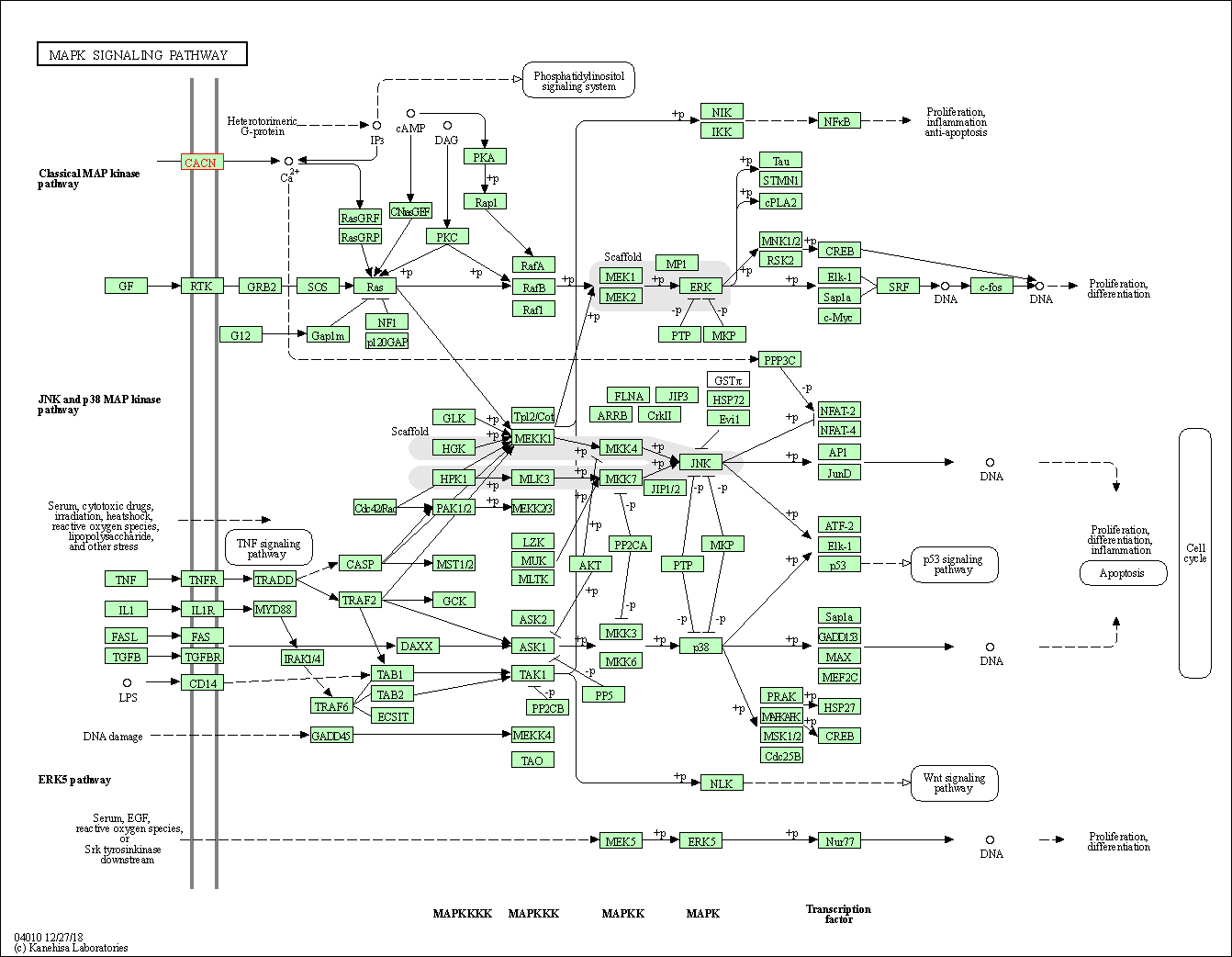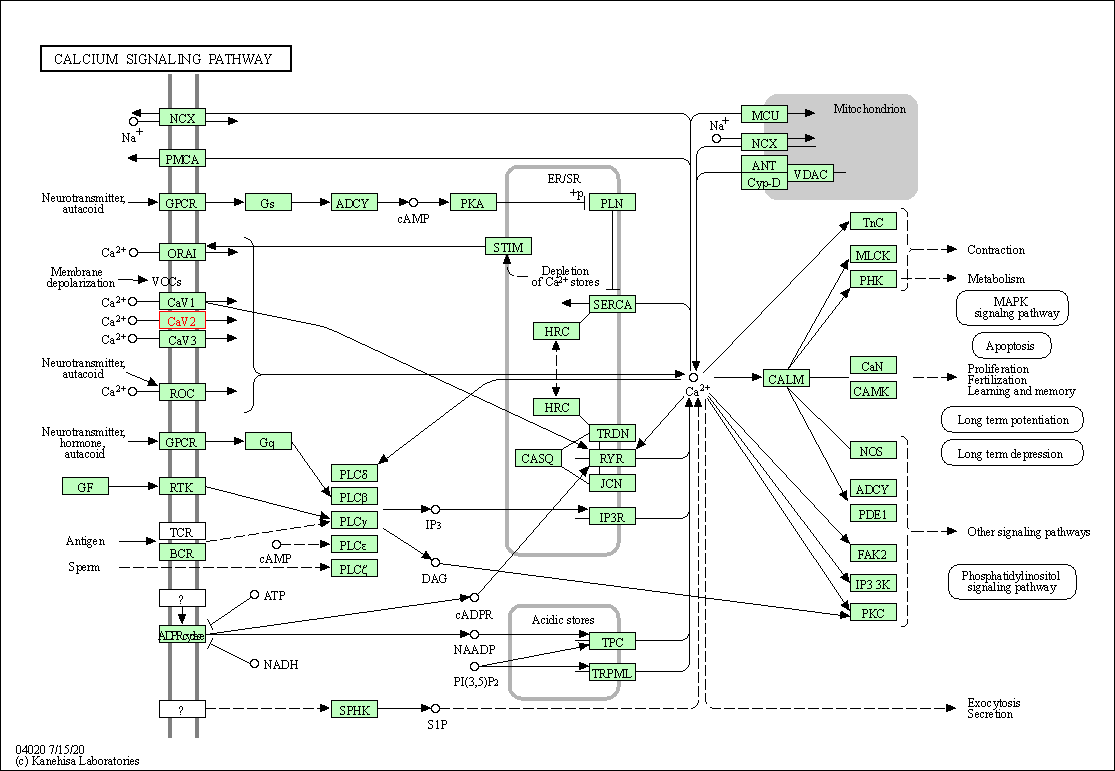Target Information
| Target General Information | Top | |||||
|---|---|---|---|---|---|---|
| Target ID |
T73977
(Former ID: TTDR00200)
|
|||||
| Target Name |
Voltage-gated calcium channel alpha Cav2.3 (CACNA1E)
|
|||||
| Synonyms |
Voltage-gated calcium channel subunit alpha Cav2.3; Voltage-gated calcium channel alpha subunit Cav2.3; Voltage-dependent R-type calcium channel subunit alpha-1E; Voltage-dependent R-type calcium channel; R-type voltage-gated calcium channel; Class E voltage-gated calcium channel; Calcium channel, Ltype, alpha-1 polypeptide, isoform 6; Calcium channel, L type, alpha-1 polypeptide, isoform 6; CACNL1A6; CACH6; Brain calcium channel II; BII
Click to Show/Hide
|
|||||
| Gene Name |
CACNA1E
|
|||||
| Target Type |
Literature-reported target
|
[1] | ||||
| Disease | [+] 2 Target-related Diseases | + | ||||
| 1 | Unspecific body region injury [ICD-11: ND56] | |||||
| 2 | Heart failure [ICD-11: BD10-BD1Z] | |||||
| Function |
The isoform alpha-1E gives rise to R-type calcium currents. R-type calcium channels belong to the 'high-voltage activated' (HVA) group and are blocked by nickel. They are however insensitive to dihydropyridines (DHP). Calcium channels containing alpha-1E subunit could be involved in the modulation of firing patterns of neurons which is important for information processing. Voltage-sensitive calcium channels (VSCC) mediate the entry of calcium ions into excitable cells and are also involved in a variety of calcium-dependent processes, including muscle contraction, hormone or neurotransmitter release, gene expression, cell motility, cell division and cell death.
Click to Show/Hide
|
|||||
| BioChemical Class |
Voltage-gated ion channel
|
|||||
| UniProt ID | ||||||
| Sequence |
MARFGEAVVARPGSGDGDSDQSRNRQGTPVPASGQAAAYKQTKAQRARTMALYNPIPVRQ
NCFTVNRSLFIFGEDNIVRKYAKKLIDWPPFEYMILATIIANCIVLALEQHLPEDDKTPM SRRLEKTEPYFIGIFCFEAGIKIVALGFIFHKGSYLRNGWNVMDFIVVLSGILATAGTHF NTHVDLRTLRAVRVLRPLKLVSGIPSLQIVLKSIMKAMVPLLQIGLLLFFAILMFAIIGL EFYSGKLHRACFMNNSGILEGFDPPHPCGVQGCPAGYECKDWIGPNDGITQFDNILFAVL TVFQCITMEGWTTVLYNTNDALGATWNWLYFIPLIIIGSFFVLNLVLGVLSGEFAKERER VENRRAFMKLRRQQQIERELNGYRAWIDKAEEVMLAEENKNAGTSALEVLRRATIKRSRT EAMTRDSSDEHCVDISSVGTPLARASIKSAKVDGVSYFRHKERLLRISIRHMVKSQVFYW IVLSLVALNTACVAIVHHNQPQWLTHLLYYAEFLFLGLFLLEMSLKMYGMGPRLYFHSSF NCFDFGVTVGSIFEVVWAIFRPGTSFGISVLRALRLLRIFKITKYWASLRNLVVSLMSSM KSIISLLFLLFLFIVVFALLGMQLFGGRFNFNDGTPSANFDTFPAAIMTVFQILTGEDWN EVMYNGIRSQGGVSSGMWSAIYFIVLTLFGNYTLLNVFLAIAVDNLANAQELTKDEQEEE EAFNQKHALQKAKEVSPMSAPNMPSIERDRRRRHHMSMWEPRSSHLRERRRRHHMSVWEQ RTSQLRKHMQMSSQEALNREEAPTMNPLNPLNPLSSLNPLNAHPSLYRRPRAIEGLALGL ALEKFEEERISRGGSLKGDGGDRSSALDNQRTPLSLGQREPPWLARPCHGNCDPTQQEAG GGEAVVTFEDRARHRQSQRRSRHRRVRTEGKESSSASRSRSASQERSLDEAMPTEGEKDH ELRGNHGAKEPTIQEERAQDLRRTNSLMVSRGSGLAGGLDEADTPLVLPHPELEVGKHVV LTEQEPEGSSEQALLGNVQLDMGRVISQSEPDLSCITANTDKATTESTSVTVAIPDVDPL VDSTVVHISNKTDGEASPLKEAEIREDEEEVEKKKQKKEKRETGKAMVPHSSMFIFSTTN PIRRACHYIVNLRYFEMCILLVIAASSIALAAEDPVLTNSERNKVLRYFDYVFTGVFTFE MVIKMIDQGLILQDGSYFRDLWNILDFVVVVGALVAFALANALGTNKGRDIKTIKSLRVL RVLRPLKTIKRLPKLKAVFDCVVTSLKNVFNILIVYKLFMFIFAVIAVQLFKGKFFYCTD SSKDTEKECIGNYVDHEKNKMEVKGREWKRHEFHYDNIIWALLTLFTVSTGEGWPQVLQH SVDVTEEDRGPSRSNRMEMSIFYVVYFVVFPFFFVNIFVALIIITFQEQGDKMMEECSLE KNERACIDFAISAKPLTRYMPQNRHTFQYRVWHFVVSPSFEYTIMAMIALNTVVLMMKYY SAPCTYELALKYLNIAFTMVFSLECVLKVIAFGFLNYFRDTWNIFDFITVIGSITEIILT DSKLVNTSGFNMSFLKLFRAARLIKLLRQGYTIRILLWTFVQSFKALPYVCLLIAMLFFI YAIIGMQVFGNIKLDEESHINRHNNFRSFFGSLMLLFRSATGEAWQEIMLSCLGEKGCEP DTTAPSGQNENERCGTDLAYVYFVSFIFFCSFLMLNLFVAVIMDNFEYLTRDSSILGPHH LDEFVRVWAEYDRAACGRIHYTEMYEMLTLMSPPLGLGKRCPSKVAYKRLVLMNMPVAED MTVHFTSTLMALIRTALDIKIAKGGADRQQLDSELQKETLAIWPHLSQKMLDLLVPMPKA SDLTVGKIYAAMMIMDYYKQSKVKKQRQQLEEQKNAPMFQRMEPSSLPQEIIANAKALPY LQQDPVSGLSGRSGYPSMSPLSPQDIFQLACMDPADDGQFQERQSLEPEVSELKSVQPSN HGIYLPSDTQEHAGSGRASSMPRLTVDPQVVTDPSSMRRSFSTIRDKRSNSSWLEEFSME RSSENTYKSRRRSYHSSLRLSAHRLNSDSGHKSDTHRSGGRERGRSKERKHLLSPDVSRC NSEERGTQADWESPERRQSRSPSEGRSQTPNRQGTGSLSESSIPSVSDTSTPRRSRRQLP PVPPKPRPLLSYSSLIRHAGSISPPADGSEEGSPLTSQALESNNACLTESSNSPHPQQSQ HASPQRYISEPYLALHEDSHASDCGEEETLTFEAAVATSLGRSNTIGSAPPLRHSWQMPN GHYRRRRRGGPGPGMMCGAVNNLLSDTEEDDKC Click to Show/Hide
|
|||||
| 3D Structure | Click to Show 3D Structure of This Target | AlphaFold | ||||
| Drugs and Modes of Action | Top | |||||
|---|---|---|---|---|---|---|
| Discontinued Drug(s) | [+] 1 Discontinued Drugs | + | ||||
| 1 | TH-9229 | Drug Info | Terminated | Reperfusion injury | [2] | |
| Mode of Action | [+] 1 Modes of Action | + | ||||
| Modulator | [+] 2 Modulator drugs | + | ||||
| 1 | TH-9229 | Drug Info | [1] | |||
| 2 | CPU-228 | Drug Info | [3] | |||
| Cell-based Target Expression Variations | Top | |||||
|---|---|---|---|---|---|---|
| Cell-based Target Expression Variations | ||||||
| Different Human System Profiles of Target | Top |
|---|---|
|
Human Similarity Proteins
of target is determined by comparing the sequence similarity of all human proteins with the target based on BLAST. The similarity proteins for a target are defined as the proteins with E-value < 0.005 and outside the protein families of the target.
A target that has fewer human similarity proteins outside its family is commonly regarded to possess a greater capacity to avoid undesired interactions and thus increase the possibility of finding successful drugs
(Brief Bioinform, 21: 649-662, 2020).
Human Tissue Distribution
of target is determined from a proteomics study that quantified more than 12,000 genes across 32 normal human tissues. Tissue Specificity (TS) score was used to define the enrichment of target across tissues.
The distribution of targets among different tissues or organs need to be taken into consideration when assessing the target druggability, as it is generally accepted that the wider the target distribution, the greater the concern over potential adverse effects
(Nat Rev Drug Discov, 20: 64-81, 2021).
Human Pathway Affiliation
of target is determined by the life-essential pathways provided on KEGG database. The target-affiliated pathways were defined based on the following two criteria (a) the pathways of the studied target should be life-essential for both healthy individuals and patients, and (b) the studied target should occupy an upstream position in the pathways and therefore had the ability to regulate biological function.
Targets involved in a fewer pathways have greater likelihood to be successfully developed, while those associated with more human pathways increase the chance of undesirable interferences with other human processes
(Pharmacol Rev, 58: 259-279, 2006).
Human Similarity Proteins
Human Tissue Distribution
Human Pathway Affiliation
|
|
| Protein Name | Pfam ID | Percentage of Identity (%) | E value |
|---|---|---|---|
| Polycystic kidney disease 2-like 1 (TRPP2) | 27.778 (40/144) | 6.28E-04 |
|
Note:
If a protein has TS (tissue specficity) scores at least in one tissue >= 2.5, this protein is called tissue-enriched (including tissue-enriched-but-not-specific and tissue-specific). In the plots, the vertical lines are at thresholds 2.5 and 4.
|
| KEGG Pathway | Pathway ID | Affiliated Target | Pathway Map |
|---|---|---|---|
| MAPK signaling pathway | hsa04010 | Affiliated Target |

|
| Class: Environmental Information Processing => Signal transduction | Pathway Hierarchy | ||
| Calcium signaling pathway | hsa04020 | Affiliated Target |

|
| Class: Environmental Information Processing => Signal transduction | Pathway Hierarchy | ||
| Target Regulators | Top | |||||
|---|---|---|---|---|---|---|
| Target-regulating microRNAs | ||||||
| Target Affiliated Biological Pathways | Top | |||||
|---|---|---|---|---|---|---|
| KEGG Pathway | [+] 3 KEGG Pathways | + | ||||
| 1 | MAPK signaling pathway | |||||
| 2 | Calcium signaling pathway | |||||
| 3 | Type II diabetes mellitus | |||||
| Panther Pathway | [+] 5 Panther Pathways | + | ||||
| 1 | Heterotrimeric G-protein signaling pathway-Gq alpha and Go alpha mediated pathway | |||||
| 2 | Ionotropic glutamate receptor pathway | |||||
| 3 | Metabotropic glutamate receptor group III pathway | |||||
| 4 | Metabotropic glutamate receptor group II pathway | |||||
| 5 | Thyrotropin-releasing hormone receptor signaling pathway | |||||
| References | Top | |||||
|---|---|---|---|---|---|---|
| REF 1 | Trusted, scientifically sound profiles of drug programs, clinical trials, safety reports, and company deals, written by scientists. Springer. 2015. Adis Insight (drug id 800008159) | |||||
| REF 2 | Trusted, scientifically sound profiles of drug programs, clinical trials, safety reports, and company deals, written by scientists. Springer. 2015. Adis Insight (drug id 800008159) | |||||
| REF 3 | URL: http://www.guidetopharmacology.org Nucleic Acids Res. 2015 Oct 12. pii: gkv1037. The IUPHAR/BPS Guide to PHARMACOLOGY in 2016: towards curated quantitative interactions between 1300 protein targets and 6000 ligands. (Target id: 534). | |||||
If You Find Any Error in Data or Bug in Web Service, Please Kindly Report It to Dr. Zhou and Dr. Zhang.

